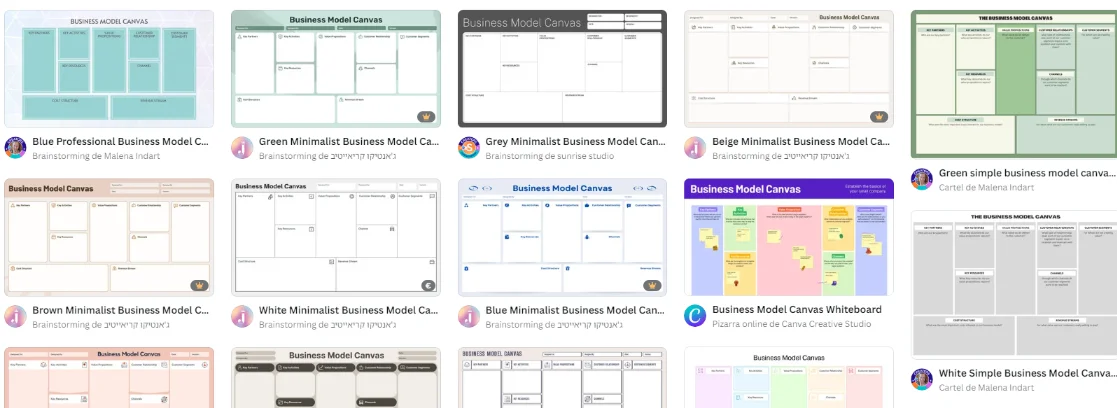Create a Business Model with Canvas
When using Canva to create your own Business Model, you can use predefined templates.

The Business Model Canvas is a strategic management tool that allows for the development and sketching of new or existing business models. It is a pre-structured visual map containing nine blocks of the business model. In this article, we will learn how to create a Business Model with Canva.
What is the Business Model Canvas?
The Business Model Canvas is a strategic management template for developing new business models or documenting existing ones. It provides a graphical representation of a series of variables that show how the company intends to make money. It is a simple and very useful tool for business decision-making.
This tool was first proposed by Alexander Osterwalder based on his previous work on business ontology. Since then, it has been widely accepted by different companies around the world due to its simplicity and effectiveness.
Business Model Templates in Canva
When using Canva to create your own Business Model, you can use predefined templates or use its content to inspire new ideas for your business.

Components of the Business Model Canvas
The Business Model Canvas consists of nine basic components that show the logic of how a company intends to make money. These nine blocks are divided into four main areas: customers, offer, infrastructure, and financial viability.
The nine blocks are: Customer Segments, Value Proposition, Channels, Customer Relationships, Revenue Streams, Key Resources, Key Activities, Key Partnerships, and Cost Structure.
Customer Segments
This component refers to the different groups of people or entities a company aims to reach and serve. To determine customer segments, the company must consider who it is creating value for and who is most willing to buy it.
Customer segments can be segmented according to various factors such as age, gender, behavior, geography, etc.
Value Proposition
The value proposition is the reason why customers choose one company over another. It clearly describes what value is delivered to customers and how their problems are solved and needs are met.
The value proposition can be innovation, design, price, etc. It is essential to differentiate the company from its competitors.
Channels
Channels describe how a company communicates with and reaches its customer segments to deliver its value proposition. Channels are touchpoints that play an important role in the customer experience.
Channels can be direct (in-store sales) or indirect (wholesalers), owned (company store) or partner (distributors), and can have different phases (awareness, evaluation, purchase, delivery, after-sales).
Customer Relationships
Customer relationships describe the type of relationship a company establishes with its customer segments. Relationships can be personal or automated and can be driven by customer acquisition, retention, or upselling.
Customer relationships can be managed and maintained through various channels, such as customer service, social media, email, etc.
Revenue Streams
Revenue streams represent the money a company generates from each customer segment. Revenue streams can be direct (product sales) or indirect (advertising, commissions).
Revenue streams can be one-time (product sale) or recurring (subscriptions, rentals, licenses).
Key Resources
Key resources are the most important assets needed to make the business model work. Key resources can be physical, financial, intellectual, or human.
Key resources can be owned by the company or leased from a partner and may be necessary for the value proposition, channels, customer relationships, or revenue streams.
Key Activities
Key activities are the most important actions a company must take for its business model to work. Key activities can be production, problem-solving, or platform/network.
Key activities may be necessary for the value proposition, channels, customer relationships, or revenue streams.
Key Partnerships
Key partnerships are the network of suppliers and partners that make the business model work. Key partnerships can be strategic (alliances between non-competitors), cooperation (alliances between competitors), joint ventures to develop new businesses, or buyer-supplier relationships to ensure reliable supplies.
Key partnerships may be necessary for the value proposition, channels, customer relationships, or revenue streams.
Cost Structure
The cost structure describes all the costs incurred to operate a business model. Costs can be calculated once key resources, key activities, and key partnerships have been identified.
The cost structure can be fixed costs (costs that do not change with production volume) or variable costs (costs that change with production volume).
How to Create a Business Model Canvas
Creating a Business Model Canvas requires strategic thinking and a clear understanding of your business. Here is a step-by-step guide on how to create a Business Model Canvas:
- Identify your customer segments: Who are your customers? What do they need? How do you want to meet their needs?
- Define your value proposition: What value do you provide to your customers? How do you differentiate from your competitors?
- Choose your distribution channels: How will you deliver your value proposition to your customers? How will you communicate with them?
- Establish your customer relationships: How will you interact with your customers? How will you maintain and improve these relationships?
- Determine your revenue streams: How will you make money? What are your revenue sources?
- Identify your key resources: What resources do you need to create value, reach markets, maintain customer relationships, and earn revenue?
- Define your key activities: What key activities does your value proposition, channels, customer relationships, and revenue streams require?
- Establish your key partnerships: Who are your key partners and suppliers? What key resources are you acquiring from partners and what key activities do partners perform?
- Calculate your cost structure: What are the most important costs inherent in your business model? What are the most expensive key resources and key activities?
Once you have completed these steps, you will have a Business Model Canvas that will help you better understand your business and make strategic decisions.
Benefits of the Business Model Canvas
The Business Model Canvas has several benefits for companies. Some of them are:
- Provides a clear and concise view of the business model.
- Helps understand and communicate the company's value proposition.
- Allows identifying and analyzing customer segments.
- Helps identify and manage key resources and key activities.
- Facilitates the identification of revenue streams and cost structure.
